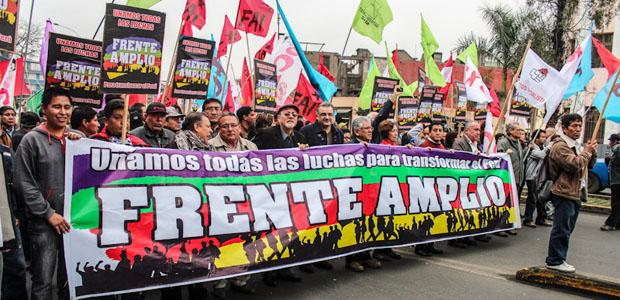Peruvians Protest Against Poverty and Corruption
Anti-government protest in Lima, Peru. (Photo: Jahir Chavez)
Roughly 8,000 Peruvians marched through the streets of Lima Saturday, one of the largest demonstrations in this country since the late 1990s. The protesters were marching toward Peru’s congressional building when clashes broke out with riot police.
Their complaints are as diverse as the protesters themselves – middle-aged bureaucrats seeking job stability to unruly soccer fans better known for their hooliganism than political activism. Yet, they shared one concern: “And where is it? Where is that national government that represents the people?”
Peru has enjoyed enviable economic expansion over the past decade. And yet government institutions remain weak, poverty persists, and corruption and crime are still rampant. President Ollanta Humala was elected on promises to ensure all Peruvians benefit from economic growth. But two years into his government, he’s been unable to implement key reforms in health care, education or policing.
And Peru’s growing middle class is getting impatient: ‘Ollanta hasn’t fulfilled those promises, and people are fed up with that,” said Eddie Perez, 21. “But now we have the opportunity to change our future.”
These latest protests began after lawmakers were caught on tape doling out judicial appointments. Young Peruvians took to Twitter, Facebook and then the streets. Congress rescinded those appointments a few days after the protests.
A few days after those protests, Congress rescinded those appointments.
“Things are different here,” said protester Luis Arteaga comparing Peru’s situation to the protests in neighboring Brazil. “The concept that unites us is that we have to take the streets to make the government reflect on what it does.”
Now the young, so-called “outraged” protesters have joined forces with the country’s biggest labor union. Nurses also march seeking better wages, gay rights activists against discrimination, archaeologists for better protection of cultural remains. Another protester, Milagros Olivera, 19, said Brazil showed Peruvians the power of protest. “It’s not just something in the Middle East. It’s something happening in Latin America,” she said.
But Peru probably won’t see the same numbers as in Brazil. Brazilians have struggled with rising prices and slower economic growth, while inflation in Peru remains moderate and unemployment is falling.
The recent bloody past also helps limit the appetite here for broad protests. A conflict between the Shining Path rebel group and the state left some 70,000 Peruvians dead in the 1980s and 90s. Social movements and the prospect of heavy policing still make many Peruvians nervous.
A couple hours into Saturday’s protest, police start firing tear gas forcing protesters to scatter. Some demonstrators hurled rocks and shouted at the officers. One young man who waved a sign that read, “Enough already, Ollanta” was dragged off.
Fifteen protesters are arrested in all. Those who lingered on the empty streets were bent over, sick from the tear gas.
“I came with a friend to support the march. They’ve fired so much tear gas,” said Jose Antonio Chavez. “This was supposed to be peaceful.”
Eventually a couple hundred protesters regroup in a nearby plaza — some more defiant than before.
